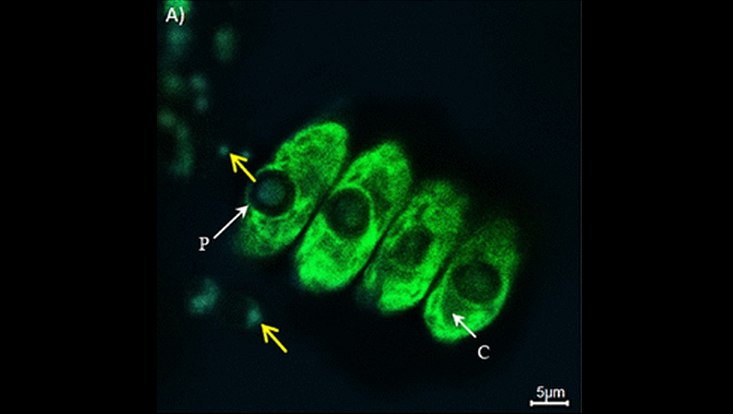Microalgae and Bacteria InteractionEvidence for Division of Diligence in the Alga Microbiota
18 August 2022, by Dr. Ines Krohn

Photo: UHH/Mikrobiologie
Microalgae are one of the most dominant forms of life on earth that is tightly associated with a distinct and specialized microbiota. We have previously shown that the microbiota of Scenedesmus quadricauda harbors less than 10 distinct microbial species. Here we provide evidence that dominant species are affiliated with the genera of Variovorax, Porphyrobacter and Dyadobacter. Experimental and transcriptome-based evidence imply that within this multispecies interaction Dyadobacter is a key to alga growth and fitness and is highly adopted to live in the phycosphere. While presumably under light conditions the alga provides the energy source to the bacteria, Dyadobacter produces and releases mainly a large variety of polysaccharides modifying enzymes. This is coherent with high level expression of the T9SS in alga co-cultures. The transcriptome data further imply that quorum quenching proteins (QQ), and biosynthesis of vitamins B1, B2, B5, B6 and B9 are expressed by Dyadobacter at high levels and in comparison to Variovorax and Porphyrobacter. Notably, Dyadobacter produces a significant number of leucine-rich repeat (LRR) proteins and enzymes involved in bacterial reactive oxygen species (ROS) tolerance. Complimentary to this, Variovorax expresses the genes of the biosynthesis of vitamins B2, B5, B6, B7, B9 and B12 and Porphyrobacter is specialized on the production of vitamins B2 and B6. Thus, the shared currency between partners are vitamins, microalgae-growth promoting substances, and dissolved carbon. This work significantly enlarges our knowledge on alga-bacteria interaction and demonstrates physiological investigations of microalgae and associated bacteria, using microscopy observations, photosynthetic activity measurements and flow cytometry.
Microalgae and Bacteria Interaction—Evidence for Division of Diligence in the Alga Microbiota
Published on 1 August 2022 in Microbiology Spectrum

